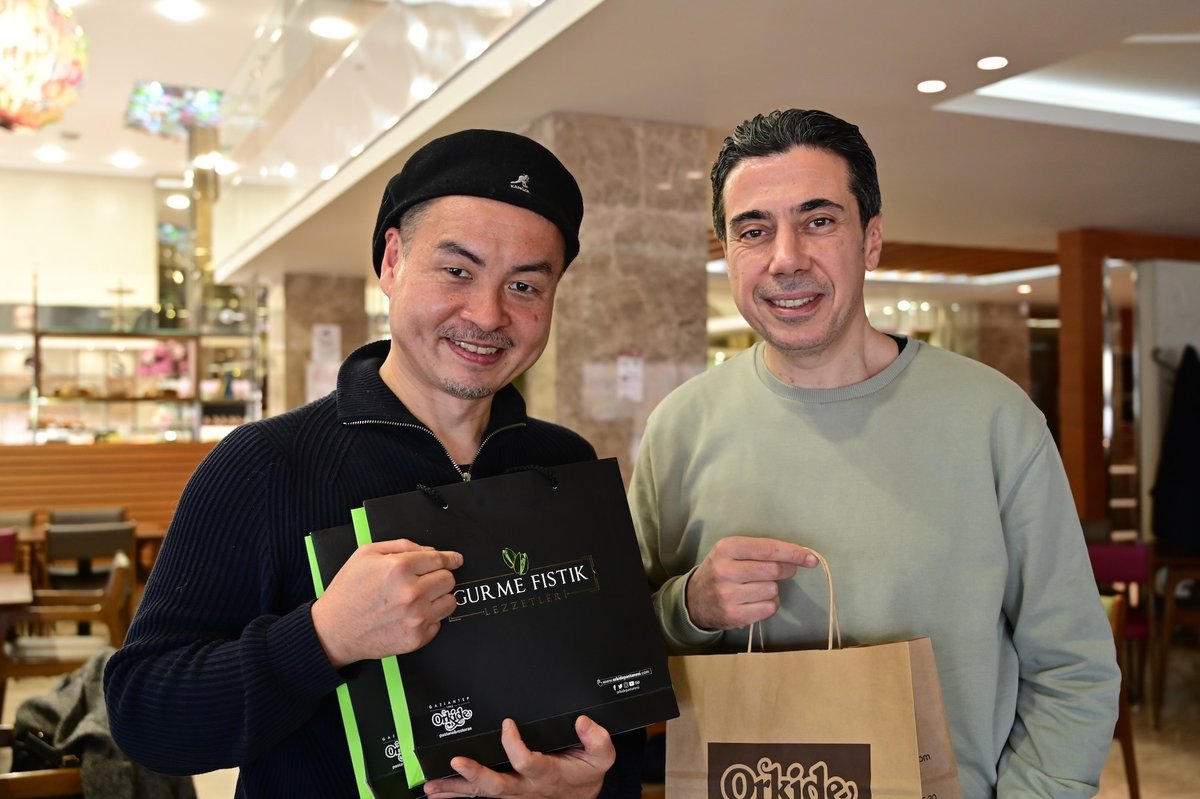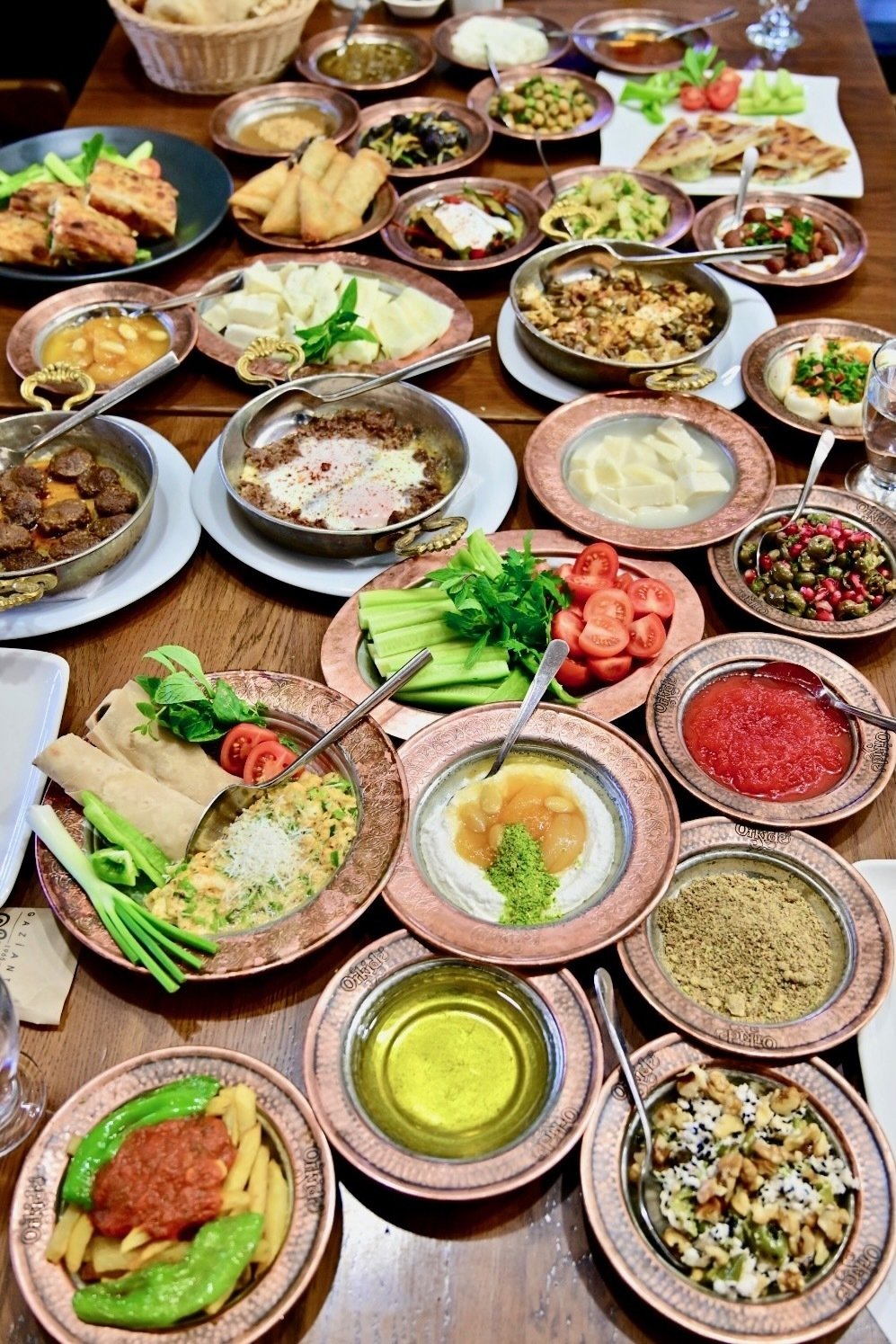
ガズィアンテプ5:29品目の豪華すぎる朝食セット!
2021年末に訪れたトルコ南東アナトリア地方の街ガズィアンテプの食い倒れ紀行第5回は全部で29品目の郷土料理が並ぶ豪華すぎる朝食セットについて。
トルコ南東部は2023年2月6日に起きたトルコ・シリア大地震で大きな被害を受けました。一刻も早い復興を願っています。
English follows Japanese.
街一番の朝食セット
2021年12月28日、ガズィアンテプに着いて四日、連日の暴飲暴食がたたり、さすがに胃腸がもたれてきた。だが、そんなことは言ってられない。朝からバクラヴァ店『Elmacıpazarı Güllüoğlu(エルマジュパザル・ギュルオウル)』の店主ムラットからこんなメッセージが届いたのだ。
「ガズィアンテプの朝食(トルコ語では「カフヴァルトゥ」)はもう食べた? 街一番の朝食で知られる老舗のお菓子屋『Orkide(オーキデ)』を紹介するよ。店主のムスタファ(Mustafa Ozguler)は僕の幼馴染なんだ。連絡先を送るから連絡すると良いよ」

街一番の朝食だって!? 実は他に食べたい料理がありすぎて、朝食まで辿り着けずにいたが、この街の朝食はなにやらテーブルに乗り切らないほど沢山の種類の料理が並ぶと聞いていた。そこで早速ムスタファに連絡すると、「今から朝食を食べに来ませんか? 午前11時にお待ちしています」と嬉しい返事が来た。
宿からタクシーに乗り、北西方面へ進むと、高層マンションとオフィスビルが立ち並ぶ閑静な街並みの新市街が続く。そんな大通りの角に「オーキデ」の大きな看板が見えてきた。タクシーを降り、真新しい建物のお店に入る。入り口は西洋菓子売り場になっていて、カラフルなケーキやマカロンやクッキーが三方向を埋めている。そこを右奥に進むとこれまた広いレストランのサロン。四人がけや八人がけのテーブルが十数台も並び、日本の大型ファミレスを高級にしたような造りだ。サロンの奥から老舗のお菓子屋さんらしい穏やかな顔つきの男性が顔を出し、話しかけてきた。

「メルハバ、私がムスタファです。私の家は代々お菓子屋ですが、この「オーキデ」は1965年に父が開きました。オーキデとは蘭のことです。そして2010年にレストランもオープンしました。当店自慢の朝食を準備しているので楽しみにしてください」
テーブルには合計29種類の料理が並ぶ!
4人用のテーブル席に座ると、濃紺のユニフォームを着たウェイターが大きなお盆を運んできた。お盆の上には15枚の小さな銅のお皿がのり、一つ一つにサラダやチーズやオリーブや揚げ物、オムレツなど、カラフルな料理が盛り付けられている。15枚のお皿をテーブルに並べていると、もう一人のウェイターが二つ目のお盆を運んできた。そこにもなんと14枚の銅のお皿が! 驚いている暇もなく、合計29品目が広いテーブルを埋め尽くした。これは8人分以上の量があるよ。今までトルコ各地で美味しくて、ゴージャスな朝食をいただいてきたが、これほど種類も多く、さらに量もたんまりなのは初めてだ。まるで中国の広州料理の宴みたいだ。

「昔はどの家も大家族だったので、家族全員が大きなテーブルに集まって、一緒に朝食を食べるという伝統がありました。その際にそれぞれが家にあるものを少しずつ持ちよってテーブルに並べて、分け合って食べました。このように沢山の種類の料理が並んだのです。7~8年前、この伝統的なスタイルをお店で再現したら面白いんじゃないかと思いつきました。最初は週末だけの提供でしたが、すぐに人気が出て、今では毎日提供しています」

それでは目の前のテーブルに並んだ29品目を一つ一つ記していこう。
浅漬け緑オリーブ入りメネメン(スクランブルエッグ)
スジュック(スパイシーなソーセージ)の薄切りのバター焼き
エト・カヴルマ(仔羊肉のホロホロ煮込み)と目玉焼き
チーズと青ネギとパセリ入りのオムレツ
お婆ちゃんのドゥリュム。赤パプリカ、パセリ、チーズを入れた焼きラップサンド
ボレッキ2種。薄い小麦粉生地で具材を包んで焼いたもの。チーズ入りとポテト入り。
チーズとパセリ入りのボレッキ
茄子とパプリカのクザルトマ(グリル)、水切りヨーグルトかけ
フライドポテトのトマトソースかけ
アラプ・キョフテスィ。ブルグル団子のパプリカペースト煮、水切りヨーグルト敷き
グリーン・サラダ。フルーツトマト、パセリ、キュウリのサラダ
ゼイティン・ピヤズ。ざく切りにした緑オリーブにザクロの実、胡桃、パセリ、青ネギ、ザクロ果汁濃縮ソースを回しかけたサラダ
ノフートル・ピヤズ。ひよこ豆、パセリ、青ネギ、クミン・パウダー、プル・ビベールを和えたサラダ
茹でたジャガイモにパセリとプル・ビベールとオリーブオイルかけ
アンタキヤ産黒オリーブ、オレンジとレモンの皮、ローズマリー和え
半熟卵を二等分し、パセリと赤パプリカのみじん切り、プル・ビベール
ロル・ペイニル。擬乳に青唐辛子と胡桃、ニゲラシード
ガズィアンテプ産チーズ
アダナ産チーズ
乾燥アンズのジャム
リンゴジャム
ズッキーニのジャム、クローブ風味
タヒーニと糖蜜のペースト
ガズィアンテプ産蜂蜜
カイマック。トルコのクロテッドクリーム
カイマックに乾燥アンズのジャムとピスタチオパウダーのせ
ザータル・ミックス
ガズィアンテプ産エクストラバージン・オリーブオイル
スィミットやポアチャなど様々な種類のパン
「ガズィアンテプの朝食はまず目で楽しむんです。それから舌、そしてお腹で楽しむ。更に料理にも3つの段階があります。第1段階は温かい料理、辛い料理です。卵料理やボレッキなどで身体を温め、食欲を刺激します。つづいて第2段階は冷たい料理、サラダやチーズです。そして最後、第3段階は甘い料理、お菓子です。まだこの後も当店自慢の特別なお菓子が出てきますから、チャイをお代わりしながら、ゆっくり時間をかけて召し上がってください」
そう言われても、とても完食できそうにないが、いくつか印象に残る料理を挙げていこう。
第1段階:温かい料理
まずは第1段階の温かい料理群から。①浅漬け緑オリーブ入りメネメン。メネメンはトルコの朝食定番のスクランブルエッグ。通常はトマトやチーズ、さらにスパイシーなソーセージのスジュックなどを入れるが、アナトリア南東部名物の浅漬け緑オリーブがたっぷり入ってるので、オリーブの塩味と出汁が卵に効いている。これは初めて!

③のエト・カヴルマと目玉焼きも初めて食べる。仔羊肉を塩とケキッキ(オレガノ)だけで6時間も煮てほぐした、仔羊版のコンビーフだ。僕の本「MEYHANE TABLE More!」にレシピを掲載しているが、それを半熟卵と組み合わせるとは!

トルコでは卵料理なしの朝食は考えられない。④のチーズと青ネギとパセリをたっぷり入れたオムレツも美味い。青ネギはアナトリア南東部でも重要なハーブの一つだ。

⑤のお婆ちゃんのドゥリュム。赤パプリカやパセリ、チーズをラワシュ(薄焼きパン)で巻いたこの料理は、ムスタファが子供の頃に彼の祖母が残り物で作ってくれたラップサンドを再現しているそう。

⑩のアラプ・キョフテスィ。挽き割り小麦のブルグルを練った小さな団子は旧市街のロカンタ「Yesemek Gaziantep Mutfağı(イェセメク・ガズィアンテプ・ムトゥファウ)」で食べたアラジャ・チョルバスやユワルラマにも使われていた。少量でお腹にたまる田舎ならではの料理だ。

第2段階:冷たい料理と第3段階:甘い料理
11からは第2段階の冷たい料理。グリーンサラダは作り置きせずに、注文が入ってから野菜を切り分けているそう。

12は今回好きになったゼイティン・ピヤズ。緑オリーブ、柘榴、胡桃、パセリ、青ネギ、ザクロ果汁濃縮ソース。

13、14、15、16はどれも茹でた野菜やオリーブにハーブやスパイスを散らしただけの簡単なサラダだが、実際に現物を見て、味わって初めて思いつく組み合わせだ。

17のロル・ペイニルは沸騰した牛乳に酢やレモン汁や酵素を加え凝固させた擬乳=フレッシュチーズ。レシピをやはり「MEYHANE TABLE More!」に掲載している。そのまま食べても美味しいところを、苦味のあるニゲラシードをたっぷり混ぜて、炒めた青唐辛子と胡桃で飾り、複雑な食感と味にしあげている。

20以降は第3段階の甘い料理。様々なジャムはもちろん自家製だ。

そして27のザータル・ミックスはシリアやレバノン、イスラエルで頻繁に用いられるハーブとスパイスのミックス。ザータル単体は英名がサマー・セボリーというハーブ。それを乾燥させて、クミンパウダー、胡麻、乾燥タラゴン、赤唐辛子粉、塩などと混ぜ合わせてある。これは28の地元産オリーブオイルと一緒に29のパンにたっぷり付けて食べるのだ。数種類あるパンもどれも美味いに違いない。しかし、これだけ多種多様な料理が目の前に並んだら、パンを口にする余裕なんてない! ああ、できることならお腹が鳴るほど空腹で訪れたかった!


「ご無理のないように。この後、当店自慢のお菓子、カトメルとバトマ・カイマックも出てきますから。そうだ。キッチンに行って、カトメル職人の自慢の技を見ませんか」
えっ、まだ料理が出てくるんですか? しかもお菓子なんて無理かも。それでもカトメルの作り方はやはり知りたい~。(続く)
Gaziantep 5: Luxurious Breakfast of 29 Dishes!
The Best Breakfast in Town
On the morning of December 28, 2021, the fourth day in Gaziantep, my stomach was starting to feel the effects of continuous feasting. But I couldn't let that stop me. Early in the morning, I received a message from Murat, the owner of the baklava shop "Elmacıpazarı Güllüoğlu."
"Have you tried the breakfast (kahvaltı in Turkish) in Gaziantep yet? Let me introduce you to 'Orkide,' an old confectionery shop known for the best breakfast in town. The owner, Mustafa Ozguler, is my childhood friend. I'll send you his contact information, so you should get in touch."
The best breakfast in town!? Actually, I had too many other dishes I wanted to try and hadn't managed to get to breakfast yet, but I'd heard that breakfast in this town consisted of a variety of dishes that couldn't all fit on the table. So, I immediately contacted Mustafa, and he responded happily, "Why don't you come for breakfast now? I'll be waiting for you at 11 AM." I took a taxi from the inn and headed northwest to a quiet new town with high-rise apartments and office buildings. On a corner of a main street, I saw a large sign for "Orkide." I got out of the taxi and entered the newly built shop. The entrance was a Western pastry shop, with colorful cakes, macarons, and cookies filling three sides. Proceeding to the back right, there was a spacious restaurant salon. It was like a high-end version of a large family restaurant in Japan, with a dozen or so tables for four or eight people. A man with a gentle face, befitting an old confectionery shop owner, emerged from the back of the salon and spoke to me.
"Merhaba, I am Mustafa. My family has been in the confectionery business for generations, and my father opened 'Orkide' in 1965. Orkide means orchid. We opened the restaurant in 2010. We're preparing our proud breakfast, so please look forward to it."
When I sat at a table for four, a waiter in a dark blue uniform brought a large tray. On the tray were 15 small copper plates, each with colorful dishes like salads, cheeses, olives, fried foods, and omelets. As the 15 plates were arranged on the table, another waiter brought a second tray with another 14 copper plates! Before I could be amazed, a total of 29 items filled the large table. This was more than enough for eight people. I had enjoyed delicious and lavish breakfasts all over Turkey, but this was the first time I had seen so many varieties and such large quantities. It was like a banquet of Cantonese cuisine in China.
29 dishes on the table!
"In the past, every household was large, and it was traditional for the whole family to gather around a big table and have breakfast together. Everyone would bring a little of what they had at home and share it on the table. That's how so many different dishes came to be served. About seven or eight years ago, I thought it would be interesting to recreate this traditional style in our shop. It started as a weekend offering, but it became so popular that we now serve it every day."
Now, let's go through the 29 items on the table in front of me.
Menemen (scrambled eggs) with lightly pickled green olives
Sliced spicy sausage (sucuk) fried in butter
Et kavurma (tender lamb stew) with a fried egg
Omelet with cheese, green onions, and parsley
Grandma's dürüm. A wrap sandwich with red peppers, parsley, and cheese
Two types of börek. Thin dough stuffed with cheese or potatoes and baked
Börek stuffed with cheese and parsley
Grilled eggplant and red peppers topped with strained yogurt
Fried potatoes with tomato sauce
Arap köftesi. Bulgur dumplings stewed in paprika paste, served on strained yogurt
Green salad with fruit tomatoes, parsley, and cucumbers
Zeytin piyaz. Salad of roughly chopped green olives with pomegranate seeds, walnuts, parsley, green onions, and pomegranate molasses
Nohutlu piyaz. Salad of chickpeas, parsley, green onions, cumin powder, and pul biber
Boiled potatoes with parsley, pul biber, and olive oil
Black olives from Antakya mixed with orange and lemon peel and rosemary
Halved soft-boiled eggs garnished with parsley, minced red peppers, and pul biber
Lor peyniri. Fresh cheese curdled from boiling milk with vinegar, lemon juice, or enzymes, garnished with green chilies, walnuts, and nigella seeds
Cheese from Gaziantep
Cheese from Adana
Dried apricot jam
Apple jam
Zucchini jam flavored with cloves
Tahini and molasses paste
Honey from Gaziantep
Kaymak. Turkish clotted cream
Kaymak topped with dried apricot jam and pistachio powder
Za'atar mix
Extra virgin olive oil from Gaziantep
Various breads including simit and poğaça
"First, Gaziantep breakfast is enjoyed with the eyes. Then with the tongue, and finally with the stomach. Moreover, there are three stages to the meal. The first stage is warm, spicy dishes like egg dishes and börek to warm you up and stimulate your appetite. The second stage is cold dishes like salads and cheeses. And the final stage is sweet dishes and desserts. Our special desserts will be served afterward, so please take your time and enjoy them with some more tea."
Even though I was told this, I couldn't possibly finish it all, but let's highlight some of the memorable dishes.
First Stage: Warm Dishes
First, from the warm dishes of the first stage. ① Menemen with lightly pickled green olives. Menemen is a traditional Turkish breakfast scrambled egg dish. It usually includes tomatoes, cheese, and sometimes spicy sausage like sucuk, but this one was filled with lightly pickled green olives, a specialty of Southeastern Anatolia, giving the eggs a distinct salty and savory flavor from the olives. This was a first for me! ③ Et kavurma with a fried egg was also a first. Tender lamb stewed for six hours with just salt and kekik (oregano), similar to lamb corned beef. The recipe is in my book "MEYHANE TABLE More!", but combining it with a soft-boiled egg was a novel idea! In Turkey, breakfast without egg dishes is unthinkable. ④ The omelet with plenty of cheese, green onions, and parsley was also delicious. Green onions are one of the important herbs in Southeastern Anatolia. ⑤ Grandma's dürüm. This wrap sandwich with red peppers, parsley, and cheese in lavash (thin flatbread) was recreated by Mustafa based on the wrap sandwiches his grandmother used to make with leftovers when he was a child. ⑩ Arap köftesi. Small bulgur dumplings were also used in the araca çorbası and yuvalama at the old town lokanta "Yesemek Gaziantep Mutfağı." A filling rural dish made with a small amount of ingredients.
Second Stage: Cold Dishes and Third Stage: Sweet Dishes
From 11 onwards were the cold dishes of the second stage. The green salad is made fresh to order, not pre-prepared. 12. Zeytin piyaz, a newfound favorite. Green olives, pomegranate seeds, walnuts, parsley, green onions, and pomegranate molasses. 13, 14, 15, and 16 were all simple salads of boiled vegetables or olives with herbs and spices, but seeing and tasting them in person gave me new ideas. 17. Lor peyniri is fresh cheese curdled from boiling milk with vinegar, lemon juice, or enzymes. The recipe is also in "MEYHANE TABLE More!". While delicious on its own, it was transformed into a complex dish with a generous mix of bitter nigella seeds, fried green chilies, and walnuts.
From 20 onwards were the sweet dishes of the third stage. All the various jams were, of course, homemade. 27. The za'atar mix, frequently used in Syria, Lebanon, and Israel, consists of dried za'atar (summer savory), cumin powder, sesame seeds, dried tarragon, red chili powder, and salt. It's eaten with plenty of the local olive oil from 28 and 29. Despite the deliciousness of the various types of bread, there's simply no room to eat them with so many dishes in front of me! Oh, how I wish I had come here with a ravenous appetite!
"Don't overexert yourself. We still have our special desserts, katmer and batma kaymak, to come. Would you like to go to the kitchen to see how katmer is made?"
What, there's more food to come? And dessert, too? I might not be able to manage that, but I still want to know how katmer is made. (To be continued)
